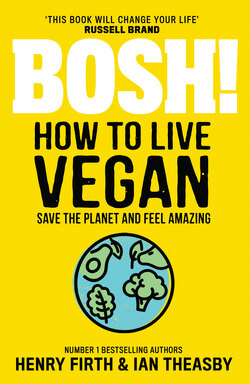Читать книгу BOSH! How to Live Vegan - Henry Firth - Страница 29
FEEDING A GROWING POPULATION
ОглавлениеThere’s another thing to consider when thinking about the sustainability of our current diets. Our nutritional needs are going to evolve over the next few decades with the human population expected to reach more than 9 billion by 2050 – a third higher than it is today.[57]
So what’s the answer? Meat? No. Increasing annual meat production is a bad idea, however we do it. All approaches will use more land, create more deforestation, more climate change, more loss of biodiversity.[58] Feeding grain to livestock increases demand for grain and drives up prices, making it harder for the world’s poor to feed themselves. If all grain were fed to humans, we could feed an extra 3.5 billion people.[59]
As Oxford University’s Joseph Poore explains, fossil fuels represent about 61% of today’s emissions.
Some estimates say as much as 40% of historic global warming is caused by forest clearance that was undertaken to make way for animal agriculture.
Currently, 25,000 species are threatened with extinction because of agriculture. Freeing up the land given over to animal farming will take some of this pressure off the global biodiversity crisis.
It will also reduce our nitrogen and phosphorus pollution, and will reduce acid rain by about a third.
A plant-based diet will reduce the amount of water we need to produce our food by 25%.[60]
Yes, there are exciting developments in lab-grown meats and these could herald cheaper, less cruel forms of meat production. Many people are also big advocates of insect protein, although the morality of farming and killing gazillions of insects is still not in line with our moral standpoint. And both are still mildly processed, lab-made foodstuffs.
What about soy then? Soy is a great source of protein for those on a plant-based diet, although it is also the main cause of rainforest deforestation, which is being torn down to provide land to support it. This is an argument often used by anti-vegans, but let’s remember that while around 70% of the world’s soy is fed directly to livestock, only 6% is turned into human food.[61] (See over the page for more on soy.)
In short, moving to a more plant-based diet is better for the planet and will reduce emissions. It will free up more land, which can then be rewilded and start to draw down carbon and solve our biodiversity crisis. And all the grain and soy which is currently fed to animals can be used to help feed the poorest nations. And the water which is not used for rearing those animals can be used for irrigating crops.
Of course, we appreciate that it is all far more complicated than that. There are good farms and bad farms. And conditions and practices differ all across the world. We all know people who keep chickens as egg-laying pets, and we can’t really compare them with a 1,000-strong battery farm where chickens never see the light of day.
There are bad ways to farm vegetables too, and we’re not advocating a move to more monocrops.
